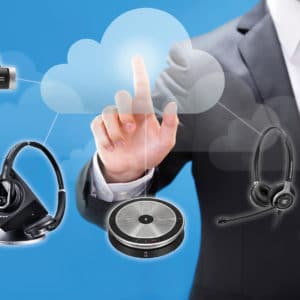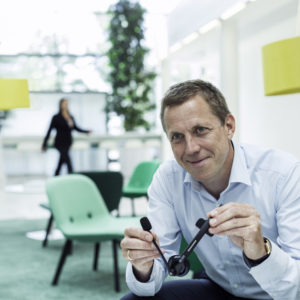A headset is no longer just a headset !
Marlow, 14th July 2016: The headset has come a long way, evolving over decades to fit every niche and level of sophistication. Today, simple headsets are bundled as free accessories to any mobile phone, giving them a perception of “nice to have” gimmicks in the consumer market. But in some areas, such as professional office environments, headsets are so much more than mere accessories, having evolved into complex pieces of IT equipment that can transform the business of communication. Jesper Kock, Director of Research and Development at Sennheiser Communications explains why that is and why the right choice of headsets is crucial for businesses.
Mr. Kock, as a business, why should we care about headsets?
The headset is probably one of the most underestimated pieces of professional equipment of modern, mobile office environments. With Unified Communications (UC) being a major ongoing trend in the industry, using headsets is simply no longer an option for businesses, but a necessity. They play an important role as a “technical interface” ensuring a seamless interaction with the company’s IT environment and, beyond this, also act as a “personal interface” – for example, when communicating directly with a client. This is where audio quality and the wearing comfort of a headset come into play. Both are important for the user experience and can ultimately impact the adoption and overall success of the UC implementation. That is why businesses should take headsets into account even in the early planning phase of their UC roll-out and consider investing in quality audio solutions. Spending millions on the UC implementation only to save money on the headsets is as bad as buying a Ferrari and then fitting it with budget tires.
How has headset development changed over the past years?
We have seen a lot of development and innovation in the past ten years alone. We are no longer developing “just a headset” but rather a complex IT device: UC headsets are powered by miniature computers working constantly to maintain optimal sound characteristics and fit into complex IT infrastructures and sound environments. Software has become paramount to the quality of communications, and is now at the heart of the development of headsets.
In their role of a technical interface, headsets need to comply with thousands of standards across the world. They need to stay compliant with softphone providers, be able to interact with phones and mobile devices from iOS to Android, from USB to classic phones. This is no small task and requires a wide range of different skills. At Sennheiser, we have significant teams of highly specialized engineers focused on dedicated development areas, such as sound engineering, embedded software development, mechanical and hardware engineering, as well as system architecture. It takes a lot of expertise and hard work to ensure that every product is compliant with all these standards and integrates seamlessly in every environment.

This is also reflected in our team: more than half of our engineers are currently working on the software for our headsets. As a personal interface, headsets transcend the role of most peripheral devices. We need to ensure that our users feel like they are in the same room as the person they are speaking to, by transmitting the clearest and most natural sound possible. This may sound simple, but it requires a lot of engineering and years of experience.
How have mobile working practices changed headset design?
As work becomes more and more mobile, we need to be able to make calls and schedule meetings regardless of our location. Truly mobile working can only become a reality when everyone can be sure that they can be clearly understood even in the most challenging sound situations, whether it’s working in a car or at an airport.
To do this, our sound engineers have perfected the right algorithms to ensure the best noise cancellation for each situation and optimize speech intelligibility and sound quality. It all comes down to a concerted effort of excellent software and hardware – for example the three specialized microphones in our PRESENCE™ system.
Another crucial aspect of modern headset designs is automation: Users have to concentrate on what they are saying so they cannot make any adjustments as they use the headset on the go. So the headset needs to adapt to the different sound environments automatically. And this automation part – making the headset know what you want before you want it – is something that demands a lot of engineering expertise and attention.

What future trends in headset development do you see?
We are currently seeing the beginning of a transition from headsets as periphery to an integral user interface component, which is able to contribute intelligently to its ecosystem and add value beyond audio.
A headset is the constant companion of many office workers already, so adding features does not require a change in daily behavior. Since headsets sit on the ears, they are for example in an ideal spot for wearable technology. In the future, we might see that professional headsets measure physiological stats, such as heart rate, body temperature, respiratory rate, muscle tension and even brain waves. Using the data gathered, a big data environment could work to optimize the office environment and the individual experience of the user.
As an added example, location data from a headset could offer opportunities for context aware computing. By using situational and environmental information about people, places and things, immediate needs can be identified and addressed automatically. By doing so, headsets will be able to help the IT ecosystem create and support an easier, more intelligent work day.
On another front, the communication experience is still, and will be for the foreseeable future, the most important feature in headset design. To establish the best possible connection between caller and called, we can use headset technology to make them feel like they are right next to each other, providing an immersive experience – a frontier we still want to reach.
We have our fingers on the pulse of innovation, working together with strong partners in a range of complementary industries, such as Microsoft. The collaboration with our parent companies Sennheiser & WDH provides us with great opportunities and exemplifies the power of partnerships: With Sennheiser’s expertise in research and audio, we are shaping the future of audio, while WDH is an expert in the development and research that we need to miniaturize further and drive the technological backbone of our headsets. As a result, our headsets are the culmination of the best qualities of both companies.
About Sennheiser:
Audio specialist Sennheiser is one of the world’s leading manufacturers of headphones, microphones and wireless transmission systems. Based in Wedemark near Hanover, Germany, Sennheiser operates its own production facilities in Germany, Ireland and the USA and is active in more than 50 countries. With 19 sales subsidiaries and long-established trading partners, the company supplies innovative products and cutting-edge audio solutions that are optimally tailored to its customers’ needs. Sennheiser is a family owned company that was founded in 1945 and which today has 2,750 employees around the world that share a passion for audio technology. Since 2013, Sennheiser has been managed by Daniel Sennheiser and Dr. Andreas Sennheiser, the third generation of the family to run the company. As part of the Sennheiser Group, the joint venture Sennheiser Communications A/S is specialized in wireless and wired headsets and speakerphones for contact centers, offices and Unified Communications environments as well as headsets for gaming and mobile devices. In 2015, the Sennheiser Group had sales totaling €682 million. www.sennheiser.com
For more information on our professional headset and speakerphone solutions, please visit www.sennheiser.com/cco or contact:
Michelle Cross
The PR Room
Email: Michelle.cross@theprroom.co.uk
Tel: 0845 094 2902
[ENDS]

